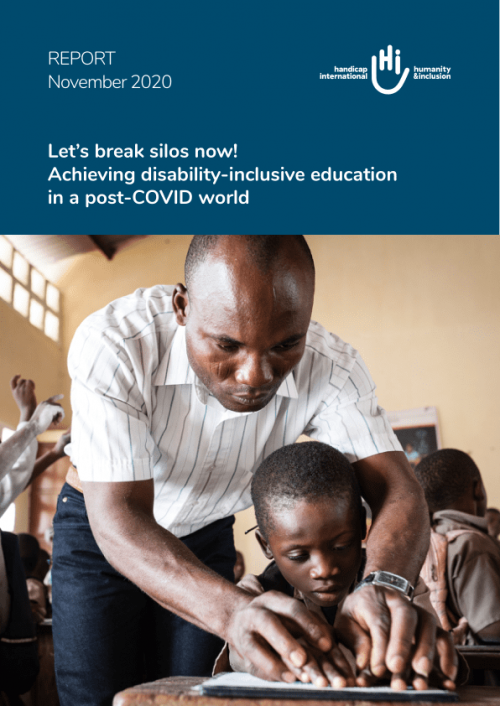
https://blog.hi.org/alert-new-report-on-inclusive-education-in-a-post-co...
PRESS RELEASE
Today, on the occasion of the International Children’s’ Day, HI releases its new advocacy report “Let’s break silos now! – Achieving disability-inclusive education in a post-COVID world”. Exclusion of children with disabilities requires action now and collaboration across sectors. Click here to download the report Children with disabilities face multiple obstacles to access and thrive […]
Today, on the occasion of the International Children’s’ Day, HI releases its new advocacy report “Let’s break silos now! – Achieving disability-inclusive education in a post-COVID world”. Exclusion of children with disabilities requires action now and collaboration across sectors.
Click here to download the report
Children with disabilities face multiple obstacles to access and thrive in education
In low- and middle-income countries, 50% of children with disabilities are out of school. More than 40% of countries in the regions of Asia, Latin America and the Caribbean still lean towards segregated education systems. These data show that the world is off track to fulfil the fundamental right to education, as set in several international human rights instruments, and to achieve Sustainable Development Goal 4 on ‘quality and inclusive education for all’.
Obstacles for the education of children with disabilities exist both within and outside the education system. Within the education system, obstacles include inaccessible infrastructures, non-adapted materials, non-adapted curricula, lack of teachers’ preparation, and segregation of children with disabilities in separated settings. Outside the education system, obstacles encompass the persisting stigma and discrimination towards persons with disabilities, limited access to quality health care, lack of assistive technologies and devices, violence and lack of security, inaccessible or unsafe journey to school, and poverty of the households.
The COVID-19 pandemic has further exacerbated inequalities in education, with children with disabilities being particularly affected by school closures, both in terms of learning and of accessing to the services that are often available through schools (nutrition, social protection, psycho-social support…).
Working across sectors to ensure that these obstacles are addressed
The existence of multiple and interconnected factors causing education exclusion requires stakeholders to break with siloed approaches and to work collaboratively across economic, social, cultural and protection sectors and domains. In times of crisis, coordinated multi-sectoral approaches are even more important to address the complexity and interdependency of children’s care, safety, wellbeing and education.
Inclusive education systems are those that cater for the needs of all learners and are able to provide quality education for all, in settings where all children learn together, free from segregation and discrimination.
Effective inclusive-education policies for children with disabilities are those that ensure that the multiple barriers faced by children with disabilities are tackled, in coordination and in partnership with stakeholders amongst civil society and public authorities, and in synergy with other sectors of intervention like health, rehabilitation, social welfare, leisure and sports, just to mention some.
The main challenge lies in the lack of coordination between the different sectors and the different categories of actors within each sector, namely government departments, donors, international organizations, civil society organizations, the private sector and foundations, but also teachers and learners.”
Houraye Mamadou Anne, Forum for African Women Educationalists
Ten years away from the expiration of Sustainable Development Goals, as governments and global education actors start to focus on learning from the COVID-19 pandemic, there is an opportunity to reimagine existing education systems, not only address the impact of the current COVID-19 pandemic on schools and learners, but also build resilience and improve inclusion through a multi-sectoral approach.

Calls for action based on experience and evidence
The extensive experience of Humanity & Inclusion and its partners across the 27 countries where we implement Inclusive education projects was crucial to develop this report and to nourish it with first-hand expertise and evidence. The Report contains arguments, testimonies, case-studies, and a list of actionable recommendations for governments in low and middle income countries, aid donors, and multilateral agencies.
In particular, the report calls on governments and donors to:
- Increase the share of domestic and international resources for free, quality and inclusive education in low-and middle-income countries. The Education Commission’s 2016 report recommended that $89 billion per year should be spent on education until 2030 in order to achieve SDG 4; this figure is now a bare minimum due to increased costs arising from the COVID pandemic.
Government only allocates limited resources each year so we have to plan around this. We had to construct a new building due to the lack of classrooms in our school so we invested our resources there. Then last year, we installed frames for the doors. Hopefully, next year we will ensure safety measures by putting in railings and other construction activities.”
Head teacher, Sarlahi, Nepal
- Adopt a twin-track approach by strengthen inclusive education systems at large, while also supporting strategies to address the specific barriers faced by children with disabilities. Realising the commitment to ‘leave no one behind’ requires investing first and foremost in the most vulnerable, with a view of equalizing opportunities and reducing gaps.
- Establish mechanisms and initiatives for cross-sectoral dialogue, coordination, and partnerships. This will allow to develop strategies where a number of linked services (i.e. rehabilitation, health, social protection, social support, nutrition…) for children with disabilities can be provided in a coordinated manner and at a single site, for instance in schools.
- Actively involve and consult persons with disabilities, parents, learners and educators, as well the organisations which represent them in the design, implementation, monitoring and evaluation of education policy and programming.










Add new comment